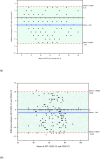Comparing ChatGPT and validated questionnaires in assessing loneliness and online social support among college students: a cross-sectional study
- PMID: 40594340
- PMCID: PMC12218135
- DOI: 10.1038/s41598-025-06358-2
Comparing ChatGPT and validated questionnaires in assessing loneliness and online social support among college students: a cross-sectional study
Abstract
The capability of ChatGPT to understand and generate human-readable text has prompted the investigation of its potential as mental health assessment tools. This study aims to explore the validity of ChatGPT in assessing loneliness and online social support among college students by comparing scoring consistency between ChatGPT and the validated questionnaires. This was a cross-sectional study between June and August 2024. We pre-trained ChatGPT-4 based on the validated University of California Los Angeles Loneliness Scale-6 (ULS-6) and Chinese Youth Version of the Online Social Support Scale (OSSS-CS), creating a structured interview questionnaire. Participants were invited to complete both the ChatGPT-created questionnaire and the validated questionnaires. We used Spearman correlation analysis, Intra-class correlation coefficients (ICC), and Bland-Altman plots to assess the agreement between the scores from ChatGPT and the validated questionnaires. In addition, we evaluated ceiling and floor effects. A total of 216 college students participated the survey. The results demonstrated a good consistency between the scores obtained from ChatGPT and the validated questionnaires, with ICC of 0.81 (95% CI 0.75-0.85, p < 0.001) for ULS-6 and 0.95 (95% CI 0.94-0.96, p < 0.001) for OSSS-CS. The Spearman correlation coefficients were 0.64 (p < 0.001) for ULS-6 and 0.89 (p < 0.001) for OSSS-CS, indicating a moderate correlation. No ceiling or floor effects were observed. The ChatGPT-created questionnaire demonstrated acceptable consistency with the validated questionnaires. Future studies can further explore the performance of ChatGPT in different populations and domains, as well as how to integrate it with validated questionnaires to enhance the accessibility of assessments.
Keywords: Artificial intelligence; ChatGPT; Large language models; Loneliness; Online social support; Questionnaires.
© 2025. The Author(s).
Conflict of interest statement
Declarations. Competing interests: The authors declare no competing interests.
Figures


Similar articles
-
Evaluating the Agreement Between ChatGPT-4 and Validated Mental Health Scales in Older Adults: A Cross-Sectional Study.Am J Geriatr Psychiatry. 2025 Oct;33(10):1049-1061. doi: 10.1016/j.jagp.2025.04.213. Epub 2025 Apr 30. Am J Geriatr Psychiatry. 2025. PMID: 40393915
-
Comparing Scoring Consistency of Large Language Models with Faculty for Formative Assessments in Medical Education.J Gen Intern Med. 2025 Jan;40(1):127-134. doi: 10.1007/s11606-024-09050-9. Epub 2024 Oct 14. J Gen Intern Med. 2025. PMID: 39402411
-
Comparison of ChatGPT and Internet Research for Clinical Research and Decision-Making in Occupational Medicine: Randomized Controlled Trial.JMIR Form Res. 2025 May 20;9:e63857. doi: 10.2196/63857. JMIR Form Res. 2025. PMID: 40393042 Free PMC article. Clinical Trial.
-
Signs and symptoms to determine if a patient presenting in primary care or hospital outpatient settings has COVID-19.Cochrane Database Syst Rev. 2022 May 20;5(5):CD013665. doi: 10.1002/14651858.CD013665.pub3. Cochrane Database Syst Rev. 2022. PMID: 35593186 Free PMC article.
-
Technological aids for the rehabilitation of memory and executive functioning in children and adolescents with acquired brain injury.Cochrane Database Syst Rev. 2016 Jul 1;7(7):CD011020. doi: 10.1002/14651858.CD011020.pub2. Cochrane Database Syst Rev. 2016. PMID: 27364851 Free PMC article.
References
-
- Lee, D. S., Stahl, J. L. & Bayer, J. B. Social resources as cognitive structures: Thinking about a dense support network increases perceived support. Soc. Psychol. Q.83, 405–422. 10.1177/0190272520939506 (2020).
-
- Expósito, F. & Moya, M. Soledad y apoyo social. Rev. Psicol. Soc.10.1174/021347499760260000 (1999).
-
- Perlman, D. & Peplau, L. A. Toward a social psychology of loneliness. Pers. Relat.3, 31–56 (1981).
Publication types
MeSH terms
Grants and funding
LinkOut - more resources
Full Text Sources

